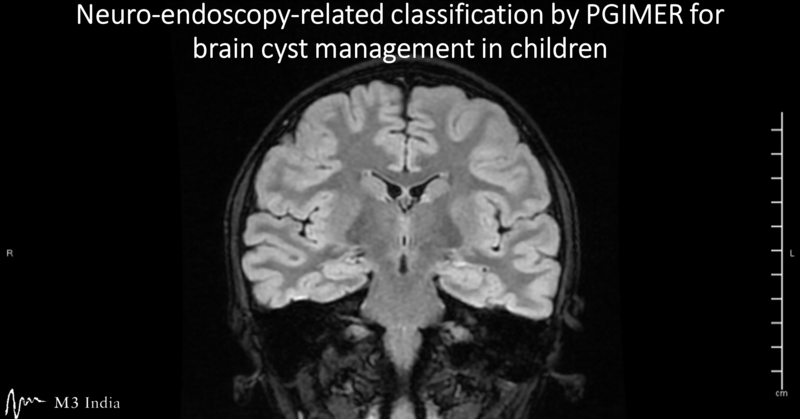Neuro-endoscopy-related classification by PGIMER for brain cyst management in children
M3 India Newsdesk Sep 30, 2019
PGIMER’s (Post Graduate Institute of Medical Education and Research, Chandigarh) guideline on management of brain cysts in children below 5 years of age, is better categorised and universal in nature. Here we elaborate upon the new, unprecedented neuro-endoscopy-related classification.

Endoscopic treatment of brain cysts in children (age<5 years) has been more of a trial than an assured treatment. The lack of specificity in the existing classifications made its management difficult.
An article titled Developmental Retrocerebellar Cysts: A New Classification for Neuroendoscopic Management and Systematic Review by Sivashanmugam Dhandapani and Sushant K. Sahoo, Department of Neurosurgery, PGIMER, have developed a guideline for better management of brain cysts in paediatrics.
Let us first look at why the existing classifications needed replacement.
Brain cyst management in paediatrics, so far
In the last decade or so, brain cysts in children below the age of 5 years have been treated through endoscopic surgeries. Even though, endoscopy made the treatment in children less elaborate, since it required just a small hole for the procedure, it certainly didn’t mean the end of cyst(s). There was a chance the symptoms could still prevail.
Moreover, the type of endoscopic surgery chosen was based on the existing classification. However, there were flaws in the existing classifications; they were not as specific and universal and there was no means of identifying the exact type of endoscopic surgery that would work for a patient. This meant trying out a type of endoscopic surgery, which the surgeon found most suitable, but it may not necessarily work. And, the patient would take longer to recuperate.
Also, the most common method applied was using a shunt between the cyst and the abdomen. The shunt or the tube would mean more surgeries for the patient once he or she grows up. Plus, it entailed many risks and side effects that could last a lifetime.
What makes the new classification better?
Researchers who led the study, believed that endoscopic surgeries based on the new classifications can help surgeons in determining the most suitable and ideal procedure for different categories of patients. Children under the age of 5 years develop cysts in the posterior of the cerebellum. As per a new classification linked to neuro-endoscopy, these cysts are called ‘developmental retrocerebellar cysts’ (DRCCs). The guideline presents classifications and sub-types for different categories of DRCCs, based on a methodical study.
Approach to the classification
The team of neurosurgeons identified three major types of DRCCs:
- Asymptomatic enlarged cistern magna was categorised as Type 0
- Cysts with a compressed fourth ventricle as Type 1
- Cysts in continuity with the fourth ventricle as Type 2
They further created subtypes to categorise the status of hydrocephalus. Hydrocephalus is a symptomatic condition, which denotes an increase in the fluid accumulation in the brain.
- If hydrocephalus was greater relative to the cyst, subtype B
- If not, subtype A
The literature presented by the PGI team was reviewed as per the PRISMA guidelines.
The study to prove the efficacy of the classifications
A sample of 13 patients between the ages of 3 months to 4 years was studied.
- 5 patients had Type 1A DRCC, with onset before 6 months. 4 of these 5 patients (80%) had intracranial hypertension. All were treated with suboccipital endoscopic deroofing and a new technique called cisternostomy (SEDC).
- 2 patients had Type 1B DRCC, with onset at 8–9 months. Endoscopic third ventriculostomy (ETV) + endoscopic ventriculocystostomy (EVC) was used for their treatment.
- 4 patients had Type 2A DRCC, with onset at 5–47 months. They were treated with SEDC.
- 2 patients had Type 2B DRCC, with onset at 6–8 months. These were treated with ETV.
The mean follow-up was of 32 months and all patients demonstrated clinicoradiologic improvement.
The new classification, when applied to other studies, reported success of ETV/EVC in only 67% of Type 1A DRCC cases and 72% of Type 2A DRCC cases. Whereas, SEDC reported 100% efficacy in the series.
Concluding remarks
This guideline presents a never-before-developed endoscopic classification of paediatric posterior fossa cysts. The classification also explains the pathophysiology, presentation, and treatment for the different DRCC categories.
Type 1 DRCC patients present early because of extraneous compression.
For Type 2 DRCC patients, the posterior fossa compliance determines the degree of hydrocephalus.
SEDC seems more suitable for Types 1A and 2A DRCCs.
ETV works adequately in Type 2B DRCC and proves effective with EVC in Type 1B.
On reviewing the patients, the PGI neurosurgeons observed that some patients showed improvement in a week’s time, whereas others took a couple of months.
The authors have pointed out that the relevance of this classification is universal. And that, unlike the older classifications, which only explained how the cysts started, the new guideline will give a better control on the management of cysts.
The PGI guideline is now published by the esteemed journal of World Neurosurgery.
Reference
Sivashanmugam Dhandapani and Sushant K. Sahoo. Developmental Retrocerebellar Cysts: A New Classification for Neuroendoscopic Management and Systematic Review [Internet] ScienceDirect; 2019 [access date Sep 20, 2019]
-
Exclusive Write-ups & Webinars by KOLs
-
Daily Quiz by specialty
-
Paid Market Research Surveys
-
Case discussions, News & Journals' summaries
